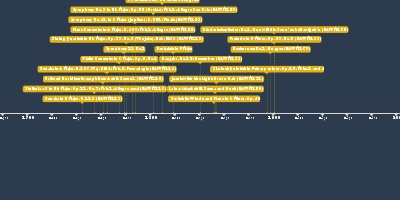jan 1, 1835 - Carnival, Op. 9: Nos. 5,6, and 7 (NAWM 132)
Description:
Composer: Robert SchumannGenre: Character pieces
The title of the set and its twenty short movements evoke a masked ball during carnival time, the period of parties, parades, masquerades, and feasting before the penitential season of Lent. The whole piece is designed to be played complete and continuously so that the succession of the individual scenes comes to suggest a narrative, though there is no strict program. Each movement has an individual character, some hinting at interactions among the dancers, some feature the costumes, and others are named for specific people (such as Paganini and Chopin). The set ends with a march in triple meter of the Davidsbund (league of David) against the Philistines, symbolizing the struggle he and other musical idealists were waging against bland, stale, or merely virtuosic music.
Ciphers and Codes
The letters ASCH frequently appear in this piece, perhaps representing Ernestine con Fricken’s home town or Ash Wednesday (the first day of lent). These letters can come from the notes A, Eb, C, B or Ab, C, B, giving Carnival a sense of unity and coherence.
No. 5 (Eusebius)
The slowest and least dancelike in the entire set, its twisting melody avoids the common arch shape and instead constantly winds back on itself. ASCH appears in the first two measures, both melodically and harmonically, though it is disguised (if Eusebius is thinking of Asch, he is also distracted). The music begins soft and thin textured, builds in both, and then recedes, emphasizing the circularity of the form and Eusebius’s reverie. All of these contribute to Eusebius being considered a contemplative dreamer.
No 6 (Florestan)
Completely contrasting the previous movement, Florestan is depicted as a passionate virtuoso through the offbeat sforzandos and cascading arpeggios in this fast waltz in G minor. He is quite mercurial, alternating the first phrase with a sudden turn to an adagio figure—which was a quote form one of Schmann's earlier works (Papillons). Schumann called this brief "flight of thought" gesture a gedankenanflug. At the end of the movement, Florestan is unable to complete the first phrase and instead obsessively repeats the opening eight notes of melody. A change to duple meter, pulsating dissonant chords without resolution, and a crescendo end the waltz in impassioned distraction.
No. 7 (Coquette)
Perhaps explaining Florestan’s distraction, the character's flirtations are suggested by a lilting dotted rhythm in a fast waltz tempo. This movement starts with a little cadential figure colored by dissonant augmented fifths, as if to supply the cadence Florestan was unable to achieve (though in the wrong key). The harmony is constantly moving forward, never settling on the tonic for long; a flirt is enticing, yet always on the move.
Everything written above is just one possible interpretation (a listener fabricated program)
Titles are not supposed to lock in a narrative but let us use our imaginations.
Added to timeline:
Date:
jan 1, 1835
Now
~ 190 years ago
